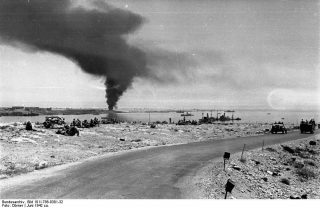Fred Greasley was an AA gunner at Tobruk during its siege in 1941/42. At the end of the siege he was captured and was a Prisoner of War for four years.
Introduction
On the 20th July, 1945, the Grantham Journal described a function on the Rectory lawn in Bottesford at which Canon A.T.G. Blackmore gave an address, A Real Welcome Home From The Church at Bottesford to Four Prisoners of War. The four were: Private Ernest Greasley (Border Regiment) taken captive at Arnhem; Gunner Fred Greasley, captured at Tobruk; Gunner Ernest H. Philpotts, taken prisoner in Crete; Captain A.C. Wright, captured in France just after Dunkirk. These men were soldiers who had been captured in the thick of battle. They had survived the fighting and also their incarceration in POW camps for prolonged lengths of time. This post is devoted to the memory of one of the four, Gunner Frederick Greasley, captured on the 20th June, 1942, and then held until the end of the war.
Family background
Frederick James Greasley was baptised on the 30th May, 1916, at Knipton, Leicestershire, son of Edward George and Annie Greasley. His father was born in 1874 at Coston, Leicestershire, son of George and Sarah Anne Greasley. His mother was Mary Ann James, from Barrow, Cottesmore, daughter of William James, a shepherd. She was 21 when she married George Edward Greasley, aged 22, a labourer, on the 9th July 1896 at St Nicholas, Cottesmore, Rutland.
In the 1939 register, the family on Main Street, Knipton, Leicestershire, were Edward George Greasley, a farm labourer born on the 7th January 1874, his wife Annie, and three sons: James F. [Frederick] born on the 16th November 1916, a bricklayer’s labourer; Edward H., b.1920, a farm labourer; and Roy b.2nd June 1924, an ironstone labourer (there are also two more persons whose records are not currently disclosed).
The family grave in Bottesford graveyard is marked by a headstone commemorating ‘Grandad George Greasley’, born in 1874, who died in April 1962, aged 88, and ‘Grandma Annie Greasley’, born in 1890, who was buried on the 1st November 1975, aged 84.
War service
Frederick James Greasley married Doris E Clarke in 1940, in the Nottingham area. We do not know more about her, though it seems likely that she outlived her husband and moved away from Bottesford. The date of the marriage must have been close to that at which he attested in 1940 and became Gunner 1593590, Royal Regiment of Artillery. He was recorded as being in Italy at one point, then “went missing” at Cyrenaica on the 20th June, 1942, when in unit 107/24 of the Light Anti-Aircraft Regiment. He was one of a host of Allied soldiers captured on that date. This was at Tobruk, as we know from Rector Albert Blackmore’s welcome address in 1945. Cyrenaica was a province of Italian Libya from 1927 until 1943, then under British administration from 1943 until 1951, before becoming part of the Kingdom of Libya.
The following notes about Tobruk and Stalag IV-C are taken from the extensive accounts in Wikipedia. On the 10th April, 1941, the Siege of Tobruk began with Australian, British and Indian forces defending the strategically vital coastal port in eastern Libya, during the North Africa Campaign. After the prolonged and tenacious siege, Axis forces captured Tobruk on the 21st June 1942, the day after Fred Greasley was captured, following a battle fought by the Panzer Army Africa, which included the Afrika Korps led by Rommel, and forces from the United Kingdom, India, South Africa and Allied contingents in the British Eighth Army (General Neil Ritchie). Thirty three thousand Allied prisoners were taken, Frederick James Greasley presumably among them. Later in 1942, on the 23rd October, Montgomery launched Operation Lightfoot, starting the Second Battle of El Alamein, and on the 5th November the Axis lines were broken. On the 13th November, Tobruk was re-captured by the Eighth Army.
Fred Greasley was transported to a Prisoner Of War camps, in his case Stalag IV-C, where he would remain for four years, until the war in Europe ended in 1945. Stalag 4C ‘Wistritz bei Teplitz’, was located just north of Teplitz (now Teplica) in the Erzgebirge (the “Ore Mountains”) in the north eastern part of the Czech Republic (then called Sudetenland). The camp was opened in February 1941. The main camp was housed in a former porcelain factory. In 1943 fewer than 250 men were there, with the remaining population, some 23,000 men, attached to various Arbeitskommandos working in local industry and construction. The largest detachment, of 8,000 men, was at Brüx (now Most) working on the construction of the Sudetenländische Treibstoffwerke (“Sudetenland Fuel Works”), part of the state-owned industrial conglomerate Reichswerke Hermann Göring. This plant was designed to process oil from coal, and as part of the Allied campaign to attack German oil production it was bombed several times between July 1944 and April 1945. In the second raid on 21 July 1944 six British POWs were killed and 21 were injured. The camp was liberated by the Russian Army in May 1945 (Wikipedia).
Following his release, Fred was brought back home, as confirmed by the Rector’s words of welcome on the Rectory lawn.
Frederick James Greasley died in 1952, seven years after his release and return to Britain, and was buried at Bottesford on the 22nd March. He was 36 years old, and had lived at Rose Lea, West End, Bottesford. We do not know the cause of his death while still a relatively young man, if it resulted from the length and hardship of his incarceration.










No Comments
Add a comment about this page